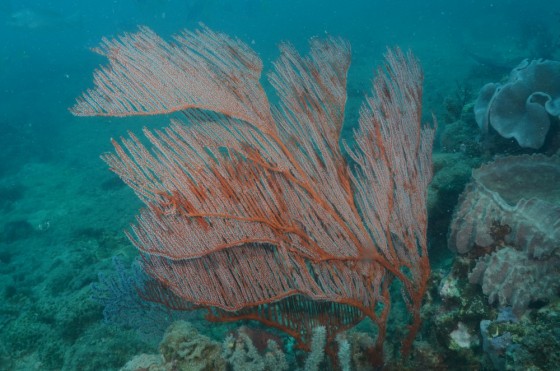Where
North Marine Parks Network
Who
Reef Life Survey, Gumurr Marthakal Rangers, Dhimurru Rangers
When
2008–2015
Why
Very little is known about the coral reef ecosystems off northern Australia. This is predominately due to the difficulties of reaching this remote region of the country, and the poor water clarity and large tidal rages which make surveys challenging. Existing information indicates that these reefs support high biodiversity and endemism, however the distribution and abundance of different species, habitats and communities are yet to be described. Coral reefs in the region are also considered vulnerable to cyclones, high turbidity, crown of thorns seastars and coral bleaching, and baseline assessments are required to identify and monitor change.
How
Reef Life Survey (RLS) dive teams surveyed 328 sites on reefs across the north marine region between 2008 and 2015. A total of 55 sites were located within the North Marine Parks Network, with numerous associated reference sites in surrounding regions. The data complied during these surveys represents the only network-wide baseline data that exists for shallow coral reefs in this region. All surveys were conducted using the standard RLS visual survey methods to record the species and abundance of mobile fishes, cryptic fishes (small fishes that live in close proximity to the seafloor) and macro-invertebrates, as well as the percentage cover of sessile animals and macroalgae. Fishes and invertebrates were assessed using visual census by trained volunteer divers along 50 metre transect lines, and percentage cover estimates used photo quadrats along the same transects. Data were analysed using statistical techniques. This dataset represents the only network-wide assessment that exists for shallow coral reefs in this region.
What did we learn?
Offshore reefs in the north marine region were rich in biota. Most species possessed widespread distributions on reefs across the central Pacific and Indian Ocean; however, numerous species restricted to inshore tropical Australian waters were also present. The majority of reefs supported high coral cover between 15–40 percent, although corals were shown to play less of a role in structuring fish communities compared to latitude and depth. Fish species richness and biomass were on average slightly higher inside marine parks compared to outside. In general reef communities within the marine parks were similar to those outside, however a few notable differences include higher densities of sea snakes and higher biomass of piscivores in the Gulf of Carpentaria Marine Park and a distinctive fish fauna in the Oceanic Shoals Marine Park. Three species listed under the Environmental Protection and Biodiversity Conservation (EPBC) Act were recorded – the green turtle (Chelonia mydas), turtle-headed seasnake (Emydocephalus annulatus) and olive seasnake (Aipysurus laevis).
What next?
This information has provided an important baseline from which future surveys can be compared to detect change. Ongoing monitoring by the RLS survey team will be important for the future management of this region, and detailed habitat mapping and characterisation will aid in conservation planning. These data can be used to develop indicators that can track changes in reef condition and biodiversity, and make decisions on zoning arrangements to ensure fish-stocks and important habitats are restored and protected.
Related data and publications
Edgar, G, Ceccarelli, D, Stuart-Smith, R and Cooper, A (2017). Reef Life Survey Assessment of Coral Reef Biodiversity in the North Commonwealth Marine Reserves Network. Report to Parks Australia and the Department of Environment.
For more information please contact marinescience@environment.gov.au.


